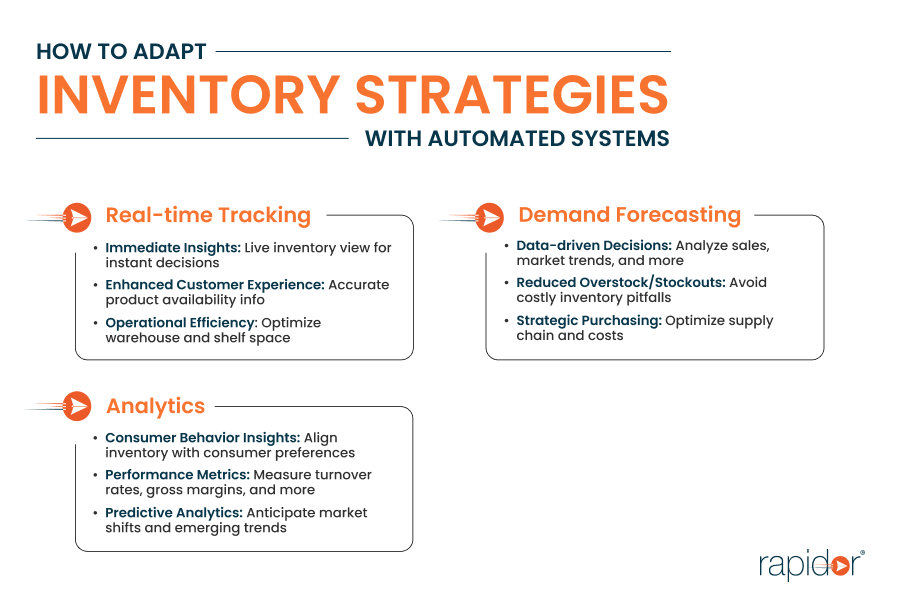Inventory management, once considered a mere backend operation, now plays a pivotal role in determining a retail business’s success. Misalignment between inventory and consumer demands can result in either stock outs or overstocking, both of which can significantly impact a retailer’s bottom line and customer satisfaction.
By harnessing the power of Automated Inventory Management Systems and integrating it with a deep understanding of Consumer Behaviours, businesses can bridge this gap. This offers a seamless experience while ensuring operational efficiency.
In this piece, we’ll discuss how consumer preferences are shaping inventory management. Moreover, the article will explore how leveraging automation can help businesses remain agile in the face of these evolving dynamics.
How has Inventory Management Changed?
In today’s swiftly evolving retail landscape, the age-old adage, “the customer is king,” has never been truer.
As the modern-day consumer wields increasing power over their purchasing decisions, businesses must ensure they are at the heart of every strategy. Enter Consumer-Centric Inventory Management – an innovative approach that prioritises the ever-changing needs and preferences of consumers in guiding inventory decisions.
Understanding consumer behaviours and preferences isn’t just a trend; it’s a necessity. The purchasing landscape has seen significant shifts over the years, with consumers demanding more personalised and immediate experiences.
This dynamism requires businesses to be agile, proactive, and adaptive in their strategies to meet and exceed customer expectations. One primary area impacted by these shifts is inventory management.
What are the Dynamics of Modern Consumer Behavior?
The evolution of the digital age has ushered in profound changes in how consumers interact with businesses and make purchasing decisions. The modern-day shopper is informed, demanding, and always on the lookout for experiences that cater precisely to their needs.
As we unpack the dynamics of modern consumer behaviour, several key trends emerge, all of which have profound implications for inventory management.
Is Online Ordering the New Normal?
The surge in online ordering is hard to ignore. Over the past decade, the convenience of browsing, selecting, and purchasing items from the comfort of one’s mobile has made B2B commerce a dominant force in the industry.
Moreover, recent global events have further accelerated this shift, making online ordering not just an option but often a preferred choice for many.
For inventory managers, this means a heightened need for real-time tracking. As consumers expect swift deliveries and accurate stock information, maintaining a real-time overview of inventory levels becomes paramount.
Automated Inventory Management Systems, equipped with real-time tracking capabilities, are no longer a luxury but a necessity in this digital age.
Is Personalised Experiences the Differentiator?
Today’s consumers are not just seeking products; they’re seeking experiences. Personalization, be it in product offerings, marketing communication, or after-sales service, is the cornerstone of modern retail. A study even found that a significant portion of consumers are willing to pay more for a personalised experience.
This drive for personalization affects inventory in two ways. First, it requires retailers to maintain a diverse range of products to cater to varied preferences.
Second, predictive analytics, a feature of many Automated Inventory Management Systems, can provide insights into individual consumer behaviours. Thus, it can enable businesses to forecast demand more accurately and ensure they stock products tailored to their customer base.
Are Sustainability Concerns A Rising Priority?
The modern consumer is increasingly eco-conscious. Concerns about the environment, ethical sourcing, and sustainability are no longer peripheral but central to many purchasing decisions.
Brands that emphasise sustainable practices often find a loyal customer base ready to support them.
For inventory strategies, this trend underscores the need for demand forecasting. Overstocking not only ties up capital and increases holding costs but, in the context of sustainability, it can lead to waste – whether in terms of unsold goods or perishable items.
Accurate demand forecasting, powered by Automated Inventory Management Systems, ensures that businesses order just what they need, minimising waste and aligning with consumer values around sustainability.
How Consumer Behavior Affects Inventory Management?
Inventory management is no longer a siloed function; it’s intricately woven into the fabric of the entire retail experience. The key thread that connects it? Consumer behaviour.
Whether it’s the products on the shelf, the promotions in the storefront, or the online inventory updates, the modern consumer’s preferences and actions deeply influence inventory decisions. But how exactly does this influence manifest?
Let’s explore the direct and indirect ways through which consumer behaviour shapes inventory management.
What are Direct Influences on Inventory Decisions?
- Product Demand: The most immediate and apparent influence is in the realm of product demand. If consumers show an increasing preference for a particular product or brand, inventory levels for that item must be adjusted accordingly to prevent stockouts.
- Seasonal Trends: Every industry has its seasonal highs and lows. Whether it’s holiday sales, summer collections, or back-to-school specials, consumer behaviours during these peak times dictate the volume and type of products retailers should stock up on.
- Product Lifecycle: As new products gain traction and older ones wane in popularity, consumer choices dictate the life cycle of a product in inventory. A sudden surge in demand for a new tech gadget or fashion trend means businesses need to quickly adjust their inventory to meet this demand.
- Feedback and Reviews: In the age of online orders, consumer reviews can make or break a product. Positive feedback can lead to higher sales, necessitating more stock, while negative reviews might mean scaling back on particular products.
What are some Indirect Influences on Inventory Decisions?
- Brand Loyalty and Retention: Consumer behaviours around brand loyalty can lead to predictable purchasing patterns. Loyal customers may consistently buy certain products, allowing businesses to use this data for more accurate demand forecasting.
- Sustainability and Ethical Choices: As mentioned earlier, the modern consumer’s eco-consciousness means they often prefer products that are ethically sourced or environmentally friendly. This shift can influence not just the kind of products businesses stock but also how they are packaged and delivered.
- Market Shifts and Global Events: Larger societal and global events can influence consumer behaviours. For instance, health trends might push consumers towards organic products, or global crises might lead to a surge in demand for specific goods. While not directly tied to individual consumer choices, these are shaped by collective consumer responses to external events.
- Technological Integration: The increasing integration of tech tools in ordering, like AR try-ons or AI assistants, can influence consumer buying patterns. Understanding and analysing data from these tools can offer insights into inventory adjustments.

How to Adapt Inventory Strategies with Automated Systems?
In the face of ever-evolving consumer behaviours, businesses must equip themselves with tools that can not only keep pace but also anticipate and adapt to these changes. Automated Inventory Management Systems stand at the forefront of this revolution, transforming traditional inventory practices into agile, consumer-centric strategies.
Let’s delve into the core features of these systems and how they enable businesses to cater more effectively to dynamic consumer behaviours.
Is Real-time Tracking taking the Pulse of Inventory?
In a world where consumers demand instant gratification, whether it’s quick deliveries or updated stock availability, real-time tracking becomes indispensable.
Immediate Insights
Real-time tracking offers businesses a live view of their inventory levels, allowing them to make instant decisions. This can be especially crucial during high-demand periods, preventing potential stockouts.
Enhanced Customer Experience
For consumers, real-time tracking translates to accurate product availability information, enhancing their experience and building trust. This feature also allows for timely communication to customers about their order status, further boosting satisfaction.
Operational Efficiency
Beyond consumer benefits, real-time tracking enhances operational efficiencies. It can highlight patterns in product movement, help identify slow-moving stock, and assist in optimising warehouse and shelf space.
How is Demand Forecasting Anticipating Customer Needs?
Forecasting is no longer about looking at past sales data alone. With demand forecasting in automated systems, businesses can make educated predictions about future product demands.
Data-driven Decisions
These systems collate data from various sources, including sales history, market trends, and external factors, providing a comprehensive view of potential demand. This holistic approach ensures more accurate forecasting.
Reduced Overstock and Stockouts
Accurate demand forecasting means businesses can avoid the pitfalls of overstocking or understocking. This not only reduces holding costs but also ensures that customer demands are consistently met.
Strategic Purchasing
With insights into future demands, businesses can make strategic purchasing decisions, availing discounts for bulk buying or optimising supply chain timings.
Why Analytics Helps in Informed Decision Making?
Analytics in automated systems offer a deep dive into inventory performance, consumer preferences, and overall business health.
- Consumer Behavior Insights: By analysing sales data, return rates, and consumer feedback, businesses can glean valuable insights into consumer preferences, allowing them to align their inventory more closely with consumer desires.
- Performance Metrics: Automated systems provide key performance indicators such as turnover rates, gross margin returns, and sell-through rates. These metrics offer businesses a clear picture of their inventory’s performance and areas of improvement.
- Predictive Analytics: Moving a step beyond traditional analytics, some advanced systems offer predictive analytics, forecasting potential market shifts or emerging consumer trends, allowing businesses to be proactive in their inventory strategies.
What are the Benefits of a Consumer-Centric Approach?
The pivot towards a consumer-centric model isn’t just a fleeting trend; it’s a strategic response to the evolving dynamics of the retail landscape. By placing consumers at the heart of inventory strategies, businesses can unlock a plethora of benefits.
Here, we’ll explore how a consumer-centric approach, amplified by Automated Inventory Management Systems, translates to tangible advantages for retail businesses.
How to Meet Increased Customer Satisfaction?
In an era where choices abound, customer loyalty hinges not just on product quality but on the overall experience.
Personalised Experiences
Understanding and anticipating consumer behaviours means businesses can tailor their offerings more closely to individual preferences. This personal touch, whether it’s in the form of product recommendations or tailored promotions, can significantly enhance the customer experience.
Reduced Stockouts
A consumer-centric approach, coupled with real-time tracking, ensures popular items are always in stock, preventing potential disappointments and ensuring a seamless experience.
Timely Communication
With accurate inventory data at their fingertips, businesses can communicate more effectively with customers about product availability, backorders, or delivery timelines, further cementing trust and satisfaction.
How to ensure Better Stock Optimization?
Striking a balance in inventory levels is a delicate dance, and a consumer-centric approach ensures businesses hit the right notes.
- Demand Forecasting: By aligning inventory strategies with consumer preferences, demand forecasting becomes more accurate. This means fewer resources are tied up in slow-moving stock, and popular items are always at the ready.
- Reduced Holding Costs: Optimised stock levels, driven by consumer demand, can lead to reduced holding and warehousing costs. With real-time tracking, businesses can make swift decisions about restocking or liquidating particular items, ensuring capital isn’t unnecessarily tied up.
- Efficient Supply Chain: A deeper understanding of consumer behaviours can streamline the supply chain. By predicting surges in demand or foreseeing potential lulls, businesses can work closely with suppliers to ensure timely and cost-effective product replenishment.
How to Turn Insights into Revenue?
The bottom line is always a priority, and a consumer-centric approach, enriched by insights from Automated Inventory Management Systems, directly impacts profitability.
- Increased Sales: By stocking products that resonate with consumer preferences and trends, businesses can drive higher sales volumes. The ability to quickly adapt to emerging trends or preferences can capture a larger market share.
- Waste Reduction: Accurate demand forecasting and stock optimization mean fewer resources are wasted on unsold or overstocked items. This efficiency directly translates to cost savings and higher profit margins.
- Loyal Customer Base: Satisfied customers often translate to repeat business. By consistently meeting and exceeding customer expectations through a consumer-centric approach, businesses can foster loyalty, ensuring a steady stream of revenue.
How will the Retail Landscape Change?
The retail landscape is in a constant state of flux, driven by the diverse and evolving preferences of the modern consumer. As we’ve explored, traditional inventory methods no longer suffice in this dynamic environment.
The key to thriving in today’s market lies in adopting a Consumer-Centric Inventory Strategy, placing the consumer at the very heart of inventory decisions.
Automated Inventory Management Systems play a pivotal role in this shift. By offering features like real-time tracking, precise demand forecasting, and deep analytics, these systems provide the tools businesses need to understand their consumers and the agility to respond effectively.
The synergy of consumer-centric strategies and automation offers a multitude of benefits. These include increased customer satisfaction and loyalty to optimised stock levels and enhanced profitability.
If there’s one takeaway from our exploration, it’s this: The future of retail is undeniably consumer-centric. Retailers, inventory managers, and C-level executives should critically assess their current inventory strategies.
Is Your Business Reactive or Proactive?
Are you merely responding to consumer behaviours or actively anticipating them?
Embrace the power of Automated Inventory Management Systems and pivot to a consumer-centric approach.
By doing so, businesses can ensure they’re keeping pace with the changing tides and leading the way for sustained success in the ever-evolving world of retail.


